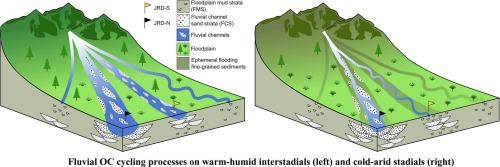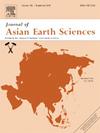千禧年的气候振荡调节了末次冰期年轻造山带的有机碳产量
IF 2.4
3区 地球科学
Q2 GEOSCIENCES, MULTIDISCIPLINARY
引用次数: 0
摘要
进入海洋的全球陆地有机碳通量中约有三分之一来自活跃造山带,这些造山带通过其在海洋中的高通量和埋藏效率,在调节大气CO2浓度和全球气候方面发挥着至关重要的作用。然而,长期气候变化与活动造山带产OC之间的关系尚不清楚。本文利用沉积相、有机地球化学和年代学等方法,分析了涿水河三角洲的长岩心,以评估末次冰期台湾造山带千年气候振荡对OC产量的影响。我们的研究结果表明,在温暖湿润的间冰期,与寒冷干旱的间冰期相比,OC产量更低,因为在温暖的时期,更强的物理侵蚀和更高的泥沙流量有利于河道中较粗的低OC沉积物的沉积。末次冰期三角洲平均OC积累速率为最近值的44.2±48.8%,表明气候变冷变干导致碳汇效应减弱。我们的研究结果强调了小山区河流系统中有机碳循环对长期气候变化的潜在负反馈。本文章由计算机程序翻译,如有差异,请以英文原文为准。

Millennial climate oscillations regulated organic carbon yields from a young orogen during the Last Glacial
Approximately one-third of the global terrestrial organic carbon (OC) flux to the oceans originates from active orogens, which play a vital role in regulating atmospheric CO2 concentrations and global climate through their high flux and burial efficiency in the oceans. However, the relationship between long-term climate change and OC yield from active orogens remains less well understood. Here, we analyse a long core from the Zhuoshui River Delta using sedimentary facies, organic geochemistry, and geochronology to evaluate the impact of millennial climate oscillations on OC yields from the Taiwan orogen during the Last Glacial. Our results show lower OC yields during warm–humid interstadials compared to cold–arid stadials, as stronger physical erosion and higher sediment discharge during warmer periods favoured the deposition of coarser, low-OC sediments in the fluvial channel. The mean OC accumulation rate in the delta during the Last Glacial is estimated as 44.2 ± 48.8 % of the recent value, indicating a diminished carbon sink effect in response to colder and drier climate. Our findings highlight the potential negative feedback of OC cycling in small mountainous river systems on long-term climate change.
求助全文
通过发布文献求助,成功后即可免费获取论文全文。
去求助
来源期刊

Journal of Asian Earth Sciences
地学-地球科学综合
CiteScore
5.90
自引率
10.00%
发文量
324
审稿时长
71 days
期刊介绍:
Journal of Asian Earth Sciences has an open access mirror journal Journal of Asian Earth Sciences: X, sharing the same aims and scope, editorial team, submission system and rigorous peer review.
The Journal of Asian Earth Sciences is an international interdisciplinary journal devoted to all aspects of research related to the solid Earth Sciences of Asia. The Journal publishes high quality, peer-reviewed scientific papers on the regional geology, tectonics, geochemistry and geophysics of Asia. It will be devoted primarily to research papers but short communications relating to new developments of broad interest, reviews and book reviews will also be included. Papers must have international appeal and should present work of more than local significance.
The scope includes deep processes of the Asian continent and its adjacent oceans; seismology and earthquakes; orogeny, magmatism, metamorphism and volcanism; growth, deformation and destruction of the Asian crust; crust-mantle interaction; evolution of life (early life, biostratigraphy, biogeography and mass-extinction); fluids, fluxes and reservoirs of mineral and energy resources; surface processes (weathering, erosion, transport and deposition of sediments) and resulting geomorphology; and the response of the Earth to global climate change as viewed within the Asian continent and surrounding oceans.
 求助内容:
求助内容: 应助结果提醒方式:
应助结果提醒方式:


